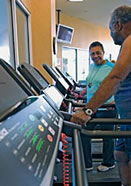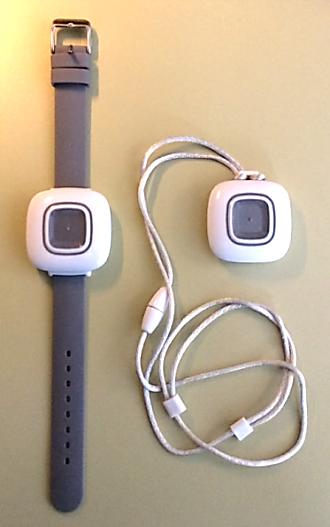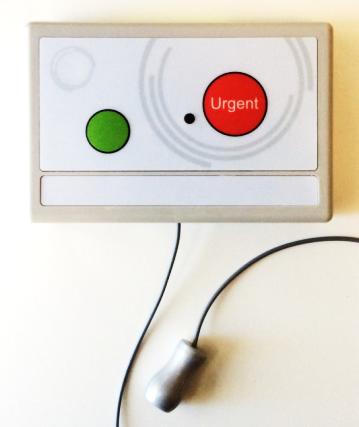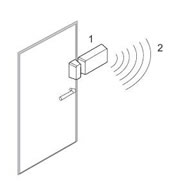Independent and Assisted Living - Coverage Everywhere

The same infrastructure described in the general PRODUCT section under Inovonics, using a Main Receiver and Repeaters, a paging system, and a computer system and software, is also used in Independent and Assisted Living facilities.
Although all the transmitters described in the general PRODUCT section can be used in Independent and Assistede Living facilities, the two main ones used are the portable wrist/neck call buttons and pull cords.
Portable wrist or neck call button for coverage everywhere

Mobility and protection for your residents – in their suites and everywhere else
Residents wearing these portable wrist or necklace call buttons will be able to call for help in their suites and anywhere in a facility, a hallway, stairwell, elevator, a common area such as the library, exercise room, dining room or their parking area, and potentially the courtyard. The software identifies the repeater that received the signal and transmits it on to the pagers to help pinpoint the location of the resident requiring assistance.
Some facilities provide residents pull cords as part of their standard monthly fee and provide the portable call buttons as an option.
Inovonics bathroom and common area pull cords

As for the transmitters installed in the residents’ bathrooms or in common areas, whenever the RED button is pressed or the pull cord is activated, a Call for Help alarm will be transmitted to the computer screen and again forwarded on to the pagers.
It will indicate both name and the room or apartment number and that it is a Call for Help.
Since there is no wiring involved, these could easily be added in future if required. It is something that your maintenance sfaff could install and thus save on installation.
Buy for today and not next year - spread expenses to match revenue
New Independent Living facilities can sometimes take from one to three years to reach full occupancy. If all the equipment in the rooms is installed when the facility opens, it could mean that the equipment a new resident gets a year down the road when he moves in is already off warranty.
New facilties can take advantage of the wireless transmitters' benefits and only order what they need when they open. Since the pull cords and call buttons are all wireless, the maintenance staff can install them as residents move in and further save on labour. Some of our customers order only 25% to 30% of the transmitters that they will require once they are completely full. They then place on-going orders as their revenue increases.
Wireless transmitters provide well for aging in place and special needs
The wireless emergency call systems go hand in hand with the concept of aging in place and/or for residents requiring special needs. Although all of the wireless peripherals are available to you, you can choose to install a basic system at installation knowing that you can add components as they are needed.
A resident in a wheel chair could benefit from a portable call button that will provide coverage everywhere in your facility. Extra pull cords in a resident's apartment could provide the extra sense of security they need.

If a resident has a habit of leaving his or her apartment at night, your maintenance staff can easily install a wireless door contact on the resident’s door and the staff would be notified if he or she opened the door, for example, between 11 p.m. and 6 a.m.
- Universal wireless RAC transmitter
- RF signal transmitted to Main or Local relay
In summary, you can install a basic system when your facility opens knowing that you can upgrade a particular apartment to suit a resident's special needs when moving in, or to keep looking after them as they age and their needs change.
The fact that you can offer a sophisticated emergency call system on a room by room basis will set you apart from other facilities while keeping your costs low. This can be the key to differentiating your facility in today's competitive environment.
Adding Assisted Living care in future
As an Independent Living facility you might decide to add an Assisted Living floor as your residents age or market conditions change. With a wireless emergency call system, it can be as simple as adding some pull cords in the residents' rooms and common areas, and redirecting the Calls for Help alarms to the pagers of the aides on the Assisted Living floor.
Responding to alarms in facilities with both Independent and Assisted Living
The Inovonics emergency call system offers full flexibility when determining who will respond to Calls for Help on a 24/7 basis. Alarms from the Independent Living floors can be directed to different pagers than those from the Assisted Living floors, with escalation to each other if not responded to in a timely manner. This programming change can be easily changed online by Can-Am Netcare. You could select that all staff respond to all alarms initially, when opening a new facility, when you have limited staff particularly on the night shift. The Administrator or Executive Director can also be notified via email if the response times exceed the criteria that he/she has set.
Moving residents from Independent to Assisted Living
In facilities offering both Independent and Assisted Living care, the decision must be made at some point whether a facility can meet the needs of certain residents on an Independent Living floor, or whether they should be moved to an Assisted Living floor. A recent example can best show the benefits of a Inovonics wireless system. A facility offering both Independent Living and Assisted Living had a resident who had a tendency to wander out of his apartment at night. Both the resident and her children resisted the recommendation to move her to the Assisted Living floor. For the children the extra cost was the main factor.
We recommended to the facility that they install a wireless door contact. We shipped one to the facility and the maintenance staff installed it on the resident's apartment door while we programmed, using remote access, a special monitoring time from 10 p.m. to 6 a.m. for that particular door. Now, when the resident opened her door during that time period, the staff received the message "Mary Smith apartment 203 wandering alarm" on their pagers. The nursing staff then had a meeting with the children and used the management reports showing the wandering alarms generated by their mother. The children agreed to move her to the Assisted Living floor so that the staff could better respond to her nightly wandering habit. Then the maintenance staff moved the wireless door contact to her new room on the Assisted Living floor to keep on monitoring her wandering habit.
This is a perfect example of the flexibility and cost effectiveness of the Inovonics wireless system. For less than $200, a facility solved their wandering resident problem. The alternative could have required the installation of a complete wandering system at a significantly higher cost or elicited the recommendation that the resident move to another facility offering dementia care.
Click here to view our Training Policies